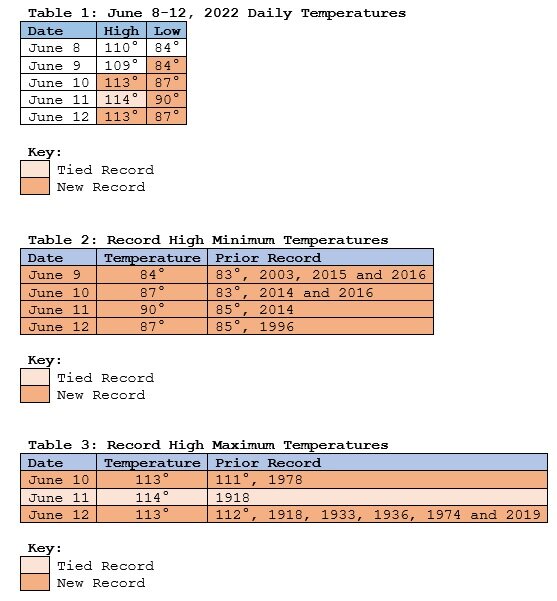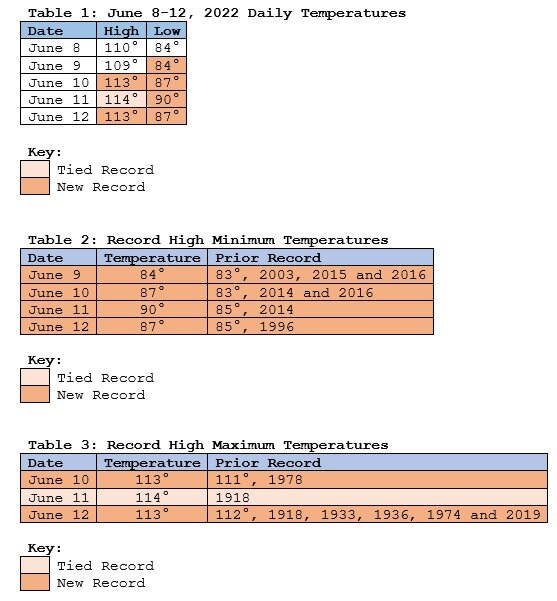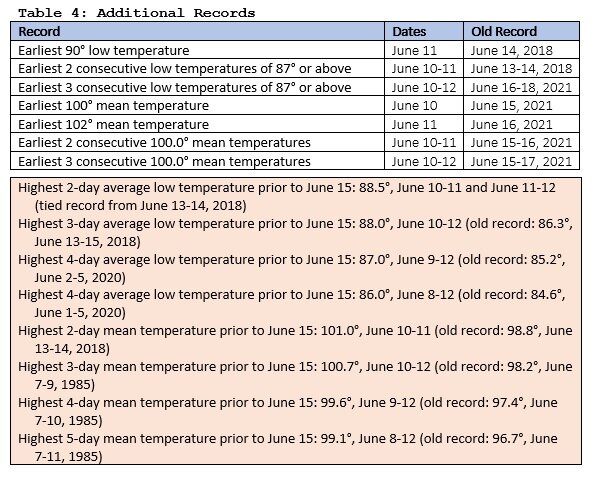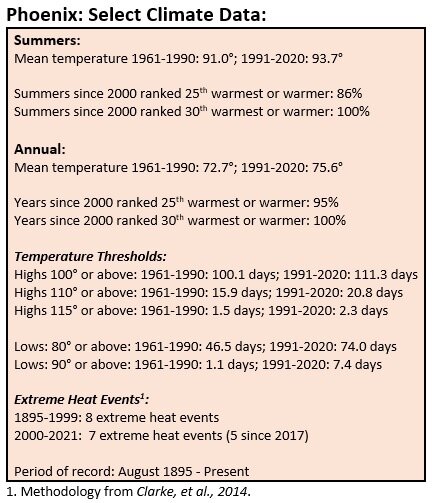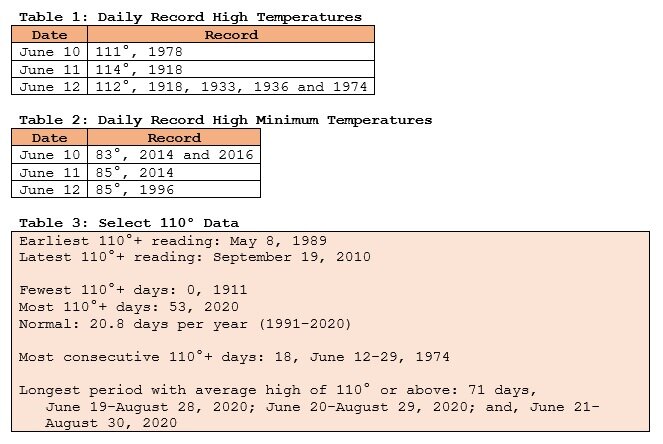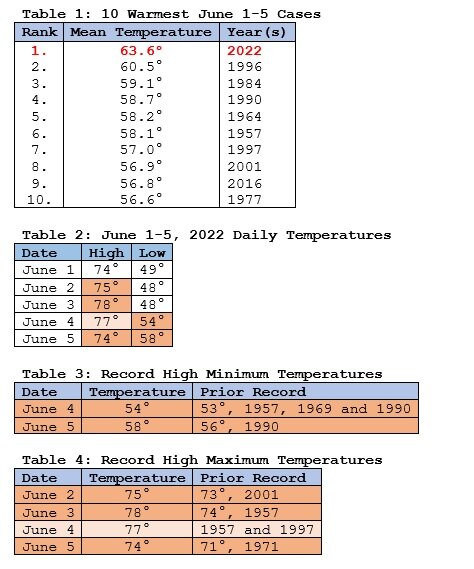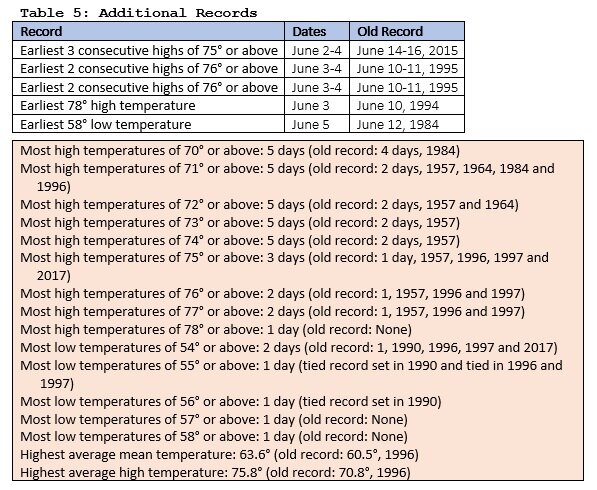-
Posts
22,985 -
Joined
Content Type
Profiles
Blogs
Forums
American Weather
Media Demo
Store
Gallery
Everything posted by donsutherland1
-
Morning thoughts… It will be partly cloudy and very warm. High temperatures will reach the middle and upper 80s in most of the region. Likely high temperatures around the region include: New York City (Central Park): 84° Newark: 89° Philadelphia: 88° Through Friday, temperatures will be generally above normal.
-

Hottest Weather So Far Lies Ahead for Phoenix
donsutherland1 replied to donsutherland1's topic in Central/Western States
- 46 replies
-
Tomorrow will be partly sunny and noticeably warmer. The remainder of the week will generally see somewhat above normal to above normal temperatures. Out west, additional high temperature records were tied or broken. Records included: Abilene, TX: 109° (old record: 106°, 1942) Cheyenne: 92° (tied record set in 1956) Phoenix: 113° (old record: 112°, 1918, 1933, 1936, 1974 and 2019) Salt Lake City: 102° (old record: 101°, 1918) San Antonio: 105° (tied record set in 1942) This heat will move into the Great Lakes region for a brief time during midweek. Temperatures from Chicago to Detroit could challenge or break daily record high temperatures. However, the core of the heat will not likely move into the Northeast. As a result, New York City will likely see temperatures peak in the middle and upper 80s. The ECMWF seasonal forecast indicates that the summer will be warmer than normal throughout the region and across much of North America. Based on how the pattern has been evolving during the spring transition to summer, it is more likely than not that the warmest anomalies of the summer will likely occur in July and August with June being the coolest of the three months in the Northeast. The latest ECMWF monthly forecast indicates that July will be warmer than June relative to normal and that August will be the warmest summer month relative to normal. The ENSO Region 1+2 anomaly was -0.6°C and the Region 3.4 anomaly was -0.9°C for the week centered around June 1. For the past six weeks, the ENSO Region 1+2 anomaly has averaged -1.33°C and the ENSO Region 3.4 anomaly has averaged -1.07°C. La Niña conditions will likely persist through the summer. The SOI was +8.58 today. The preliminary Arctic Oscillation (AO) was +1.066 today. On June 10 the MJO was in Phase 1 at an amplitude of 1.122 (RMM). The June 9-adjusted amplitude was 1.231 (RMM). Based on sensitivity analysis applied to the latest guidance, there is an implied 54% probability that New York City will have a warmer than normal June (1991-2020 normal). June will likely finish with a mean temperature near 72.4° (0.4° above normal).
-
- 1 reply
-
- 1
-

-
Morning thoughts… It will be variably cloudy with showers and thunderstorms. High temperatures will reach the lower and middle 70s in most of the region. Likely high temperatures around the region include: New York City (Central Park): 78° Newark: 82° Philadelphia: 80° Tomorrow will be partly sunny and vey warm. Normals: New York City: 30-Year: 78.7°; 15-Year: 78.6° Newark: 30-Year: 80.8°; 15-Year: 80.9° Philadelphia: 30-Year: 82.3°; 15-Year: 82.5°
-
Tomorrow will be variably cloudy with frequent showers and thunderstorms. The remainder of the week will generally see somewhat above normal to above normal temperatures. Out west, numerous high temperature records were tied or broken. Records included: Abilene, TX: 108° (old record: 105°, 2012) Corpus Christi: 97° (tied record set in 2014) Dallas-Forth Worth: 103° (tied record set in 1911) Death Valley, CA: 122° (old record: 121°, 1921) Denver: 100° (tied record set in 2013) Flagstaff: 87° (tied record set in 1910) Las Vegas: 109° (old record: 108°, 1996) Phoenix: 114° (tied record set in 1910) San Antonio: 104° (tied record set in 1942) This morning, Phoenix also recorded a low temperature of 90°. That would smash the daily record of 85° from 2014 and would be the earliest 90° minimum temperature on record. The record was set on June 14, 2018 when the low temperature was 90°. Excessive heat will continue to grip the desert Southwest through tomorrow. Phoenix will very likely again see readings of 110° or above. Additional temperature records are possible. This heat will move into the Great Lakes region for a brief time during midweek. Temperatures from Chicago to Detroit could challenge or break daily record high temperatures. However, the heat will not move into the Northeast. The ECMWF seasonal forecast indicates that the summer will be warmer than normal throughout the region and across much of North America. Based on how the pattern has been evolving during the spring transition to summer, it is more likely than not that the warmest anomalies of the summer will likely occur in July and August with June being the coolest of the three months in the Northeast. The latest ECMWF monthly forecast indicates that July will be warmer than June relative to normal and that August will be the warmest summer month relative to normal. The ENSO Region 1+2 anomaly was -0.6°C and the Region 3.4 anomaly was -0.9°C for the week centered around June 1. For the past six weeks, the ENSO Region 1+2 anomaly has averaged -1.33°C and the ENSO Region 3.4 anomaly has averaged -1.07°C. La Niña conditions will likely persist through the summer. The SOI was +6.96 today. The preliminary Arctic Oscillation (AO) was +0.444 today. On June 9 the MJO was in Phase 1 at an amplitude of 1.231 (RMM). The June 8-adjusted amplitude was 1.528 (RMM). Based on sensitivity analysis applied to the latest guidance, there is an implied 57% probability that New York City will have a warmer than normal June (1991-2020 normal). June will likely finish with a mean temperature near 72.6° (0.6° above normal).
-

Hottest Weather So Far Lies Ahead for Phoenix
donsutherland1 replied to donsutherland1's topic in Central/Western States
This morning’s low temperature in Phoenix was 90. That would crush the daily record of 85 from 2014. It would also be the earliest 90 low on record. The record was set on June 14, 2018.- 46 replies
-

Hottest Weather So Far Lies Ahead for Phoenix
donsutherland1 replied to donsutherland1's topic in Central/Western States
Phoenix finished with a high of 113 making the mean temperature 100.0.- 46 replies
-
Morning thoughts… It will be variably cloudy. High temperatures will reach the upper 70s and lower 80s in most of the region. Likely high temperatures around the region include: New York City (Central Park): 78° Newark: 82° Philadelphia: 80° Numerous showers and thunderstorms are likely tomorrow. Normals: New York City: 30-Year: 78.4°; 15-Year: 78.3° Newark: 30-Year: 80.4°; 15-Year: 80.6° Philadelphia: 30-Year: 82.0°; 15-Year: 82.2°
-

Galveston’s Record Warm Late Spring and Early Summer
donsutherland1 replied to donsutherland1's topic in Climate Change
Following two consecutive record warm months, Galveston has had its warmest first 10 days of June with a mean temperature of 86.2°. The previous record of 85.3° was set in 2008.- 29 replies
-

Hottest Weather So Far Lies Ahead for Phoenix
donsutherland1 replied to donsutherland1's topic in Central/Western States
Earlier today, Phoenix recorded a low temperature of 87°. That would easily surpass the existing mark of 83°, which was set in 2014 and tied in 2016. Through 3:25 PST, Phoenix has a high temperature of 113°. That breaks the daily record of 111° set in 1978. Finally, the daily mean temperature is 100.0°. That is the earliest such mean temperature on record. The prior mark was set just last year on June 15.- 46 replies
-
Tomorrow will be variably cloudy and a bit cooler. Overall, temperatures should remain fairly close to normal. No excessive heat appears likely through the weekend. Excessive heat is sending temperatures soaring in the desert Southwest. Earlier today, Phoenix recorded a low temperature of 87°. That would easily surpass the existing mark of 83°, which was set in 2014 and tied in 2016. Through 3:25 PST, Phoenix has a high temperature of 113°. That breaks the daily record of 111° set in 1978. Finally, the daily mean temperature is 100.0°. That is the earliest such mean temperature on record. The prior mark was set just last year on June 15. Phoenix will very likely see readings of 110° or above through the weekend. Some record high temperatures are possible. Following two consecutive record warm months, Galveston has had its warmest first 10 days of June with a mean temperature of 86.2°. The previous record of 85.3° was set in 2008. During the closing week of May, the MJO moved through Phase 6 with an amplitude as high as 1.909. The only case with an MJO passage through Phase 6 with an amplitude of 1.500 or above during that timeframe was 1998. In 1998, the second half of June was noticeably warmer than the first half. The MJO's ongoing progression and the state of Atlantic blocking could impact the outcome for the second half of June. The ECMWF seasonal forecast indicates that the summer will be warmer than normal throughout the region and across much of North America. Based on how the pattern has been evolving during the spring transition to summer, it is more likely than not that the warmest anomalies of the summer will likely occur in July and August with June being the coolest of the three months in the Northeast. The latest ECMWF monthly forecast indicates that July will be warmer than June relative to normal and that August will be the warmest summer month relative to normal. The ENSO Region 1+2 anomaly was -0.6°C and the Region 3.4 anomaly was -0.9°C for the week centered around June 1. For the past six weeks, the ENSO Region 1+2 anomaly has averaged -1.33°C and the ENSO Region 3.4 anomaly has averaged -1.07°C. La Niña conditions will likely persist through the summer. The SOI was +3.87 today. The preliminary Arctic Oscillation (AO) was -0.086 today. On June 8 the MJO was in Phase 1 at an amplitude of 1.534 (RMM). The June 7-adjusted amplitude was 1.702 (RMM). Based on sensitivity analysis applied to the latest guidance, there is an implied 56% probability that New York City will have a warmer than normal June (1991-2020 normal). June will likely finish with a mean temperature near 72.6° (0.6° above normal).
-
Morning thoughts… It will be partly sunny and warm. High temperatures will reach the upper 70s and lower 80s in most of the region. Likely high temperatures around the region include: New York City (Central Park): 79° Newark: 83° Philadelphia: 81° The weekend will be variably cloudy. Some showers and thundershowers are possible. Normals: New York City: 30-Year: 78.1°; 15-Year: 78.1° Newark: 30-Year: 80.1°; 15-Year: 80.3° Philadelphia: 30-Year: 81.7°; 15-Year: 81.9°
-
Tomorrow will be partly sunny and warm, though a little cooler than today. Overall, temperatures should remain fairly close to normal. No excessive heat appears likely through the weekend. Excessive heat is sending temperatures soaring in the desert Southwest. Through 2 pm MST, Phoenix had recorded its 20th 100° day of 2022. Normal through June 9th is 16.0 days. Phoenix, which set a daily record high minimum temperature of 84° today, will very likely see readings of 110° or above through the weekend. Some record high temperatures are possible. During the closing week of May, the MJO moved through Phase 6 with an amplitude as high as 1.909. The only case with an MJO passage through Phase 6 with an amplitude of 1.500 or above during that timeframe was 1998. In 1998, the second half of June was noticeably warmer than the first half. The MJO's ongoing progression and the state of Atlantic blocking could impact the outcome for the second half of June. The ECMWF seasonal forecast indicates that the summer will be warmer than normal throughout the region and across much of North America. Based on how the pattern has been evolving during the spring transition to summer, it is more likely than not that the warmest anomalies of the summer will likely occur in July and August with June being the coolest of the three months in the Northeast. The latest ECMWF monthly forecast indicates that July will be warmer than June relative to normal and that August will be the warmest summer month relative to normal. The ENSO Region 1+2 anomaly was -0.6°C and the Region 3.4 anomaly was -0.9°C for the week centered around June 1. For the past six weeks, the ENSO Region 1+2 anomaly has averaged -1.33°C and the ENSO Region 3.4 anomaly has averaged -1.07°C. La Niña conditions will likely persist through the summer. The SOI was +8.79 today. The preliminary Arctic Oscillation (AO) was -0.757 today. On June 7 the MJO was in Phase 1 at an amplitude of 1.709 (RMM). The June 6-adjusted amplitude was 1.847 (RMM). Based on sensitivity analysis applied to the latest guidance, there is an implied 56% probability that New York City will have a warmer than normal June (1991-2020 normal). June will likely finish with a mean temperature near 72.7° (0.7° above normal).
-
Morning thoughts… Rain and thunderstorms will come to an end this morning. the sun will return afterward. High temperatures will reach the lower and middle 80s in most of the region. Likely high temperatures around the region include: New York City (Central Park): 80° Newark: 85° Philadelphia: 84° Tomorrow will be partly sunny and pleasant. Normals: New York City: 30-Year: 77.8°; 15-Year: 77.8° Newark: 30-Year: 79.8°; 15-Year: 80.0° Philadelphia: 30-Year: 81.3°; 15-Year: 81.6°
-

Hottest Weather So Far Lies Ahead for Phoenix
donsutherland1 replied to donsutherland1's topic in Central/Western States
Phoenix reached 110° for the first time this year. Last year, Phoenix saw 22 such days. Normal is 20.8 days per year.- 46 replies
-
The weather will remain fairly unsettled into at least the first half of the weekend. Showers and thunderstorms will return and continue into tomorrow morning. Parts of the region could pick up 0.50"-1.50" of rain with some locally higher amounts. Overall, temperatures should remain fairly close to normal. No excessive heat appears likely through the weekend. Excessive heat will develop in the desert Southwest by tomorrow. Phoenix will very likely see its first 110° or above temperatures of the year. During 1961-90, Phoenix averaged 15.9 110°+ days per year. For the 1991-20 base period, that number has increased to 20.8 days. During the closing week of May, the MJO moved through Phase 6 with an amplitude as high as 1.909. The only case with an MJO passage through Phase 6 with an amplitude of 1.500 or above during that timeframe was 1998. In 1998, the second half of June was noticeably warmer than the first half. The MJO's ongoing progression and the state of Atlantic blocking could impact the outcome for the second half of June. The ECMWF seasonal forecast indicates that the summer will be warmer than normal throughout the region and across much of North America. Based on how the pattern has been evolving during the spring transition to summer, it is more likely than not that the warmest anomalies of the summer will likely occur in July and August with June being the coolest of the three months in the Northeast. The ENSO Region 1+2 anomaly was -0.6°C and the Region 3.4 anomaly was -0.9°C for the week centered around June 1. For the past six weeks, the ENSO Region 1+2 anomaly has averaged -1.33°C and the ENSO Region 3.4 anomaly has averaged -1.07°C. La Niña conditions will likely persist through the summer. The SOI was +16.17 today. The preliminary Arctic Oscillation (AO) was -1.209 today. On June 6 the MJO was in Phase 8 at an amplitude of 1.858 (RMM). The June 5-adjusted amplitude was 1.945 (RMM). Based on sensitivity analysis applied to the latest guidance, there is an implied 57% probability that New York City will have a warmer than normal June (1991-2020 normal). June will likely finish with a mean temperature near 72.7° (0.7° above normal).
-

Hottest Weather So Far Lies Ahead for Phoenix
donsutherland1 replied to donsutherland1's topic in Central/Western States
Phoenix’s increasing heat is a product of both the urban heat island effect and climate change. The warming has been fairly rapid.- 46 replies
-

Anchorage's Record-Breaking Summer of 2019
donsutherland1 replied to donsutherland1's topic in Climate Change
Anchorage recorded its warmest first week of June on record: Mean temperature: 62.1° (old record: 59.7°, 1997) Average high: 72.3° (old record: 70.0°, 1996) Average low: 51.9° (old record: 51.3°, 1990) -

Galveston’s Record Warm Late Spring and Early Summer
donsutherland1 replied to donsutherland1's topic in Climate Change
Following back-to-back record warm months, Galveston recorded its warmest first week of June on record. The mean temperature was 85.6° (old record: 85.4°, 2008). The average high of 90.7° and average low of 80.4° both ranked second. Record high minimum temperatures were set on June 6 (83°; old record: 81°, 1974, 1990, 2004, 2005, 2008, and 2020) and June 7 (83°; old record: 82°, 1990 and 1994).- 29 replies
-
- 1
-

-
Morning thoughts… Clouds will yield to sunshine. It will be warm. High temperatures will reach the lower and middle 80s in most of the region. Likely high temperatures around the region include: New York City (Central Park): 82° Newark: 86° Philadelphia: 86° Rain and thunderstorms are likely tonight into tomorrow. Normals: New York City: 30-Year: 77.5°; 15-Year: 77.5° Newark: 30-Year: 79.4°; 15-Year: 79.7° Philadelphia: 30-Year: 81.0°; 15-Year: 81.3°
-
Starting tomorrow, Phoenix will experience its hottest weather so far this year. High temperatures will very likely peak above 110 degrees on multiple days. The hottest days will likely be Friday-Sunday.
- 46 replies
-
The weather will remain fairly unsettled into at least the first half of the weekend. Showers, thundershowers, and periods of rain tomorrow. It will likely be a bit warmer. Overall, temperatures should remain fairly close to normal. No excessive heat appears likely through the weekend. Excessive heat will develop in the desert Southwest by Thursday or Friday. Phoenix will likely see its first 110° or above temperatures of the year. During 1961-90, Phoenix averaged 15.9 110°+ days per year. For the 1991-20 base period, that number has increased to 20.8 days. During the closing week of May, the MJO moved through Phase 6 with an amplitude as high as 1.909. The only case with an MJO passage through Phase 6 with an amplitude of 1.500 or above during that timeframe was 1998. In 1998, the second half of June was noticeably warmer than the first half. The MJO's ongoing progression and the state of Atlantic blocking could impact the outcome for the second half of June. The ECMWF seasonal forecast indicates that the summer will be warmer than normal throughout the region and across much of North America. Based on how the pattern has been evolving during the spring transition to summer, it is more likely than not that the warmest anomalies of the summer will likely occur in July and August with June being the coolest of the three months in the Northeast. The ENSO Region 1+2 anomaly was -0.6°C and the Region 3.4 anomaly was -0.9°C for the week centered around June 1. For the past six weeks, the ENSO Region 1+2 anomaly has averaged -1.33°C and the ENSO Region 3.4 anomaly has averaged -1.07°C. La Niña conditions will likely persist through the summer. The SOI was +28.54 today. The preliminary Arctic Oscillation (AO) was -1.421 today. On June 5 the MJO was in Phase 8 at an amplitude of 1.946 (RMM). The June 4-adjusted amplitude was 2.179 (RMM). Based on sensitivity analysis applied to the latest guidance, there is an implied 55% probability that New York City will have a warmer than normal June (1991-2020 normal). June will likely finish with a mean temperature near 72.7° (0.7° above normal).
-
Morning thoughts… Clouds will increase. Showers and periods of rain are likely overnight. High temperatures will reach the upper 70s and lower 80s in most of the region. Likely high temperatures around the region include: New York City (Central Park): 77° Newark: 82° Philadelphia: 81° Additional rain is likely tomorrow. Normals: New York City: 30-Year: 77.2°; 15-Year: 77.2° Newark: 30-Year: 79.1°; 15-Year: 79.4° Philadelphia: 30-Year: 80.7°; 15-Year: 81.0°
-

Anchorage's Record-Breaking Summer of 2019
donsutherland1 replied to donsutherland1's topic in Climate Change
Anchorage just experienced its warmest first five days of June on record. The mean temperature of 63.6° surpassed the old mark by 3.1°. Some charts:


